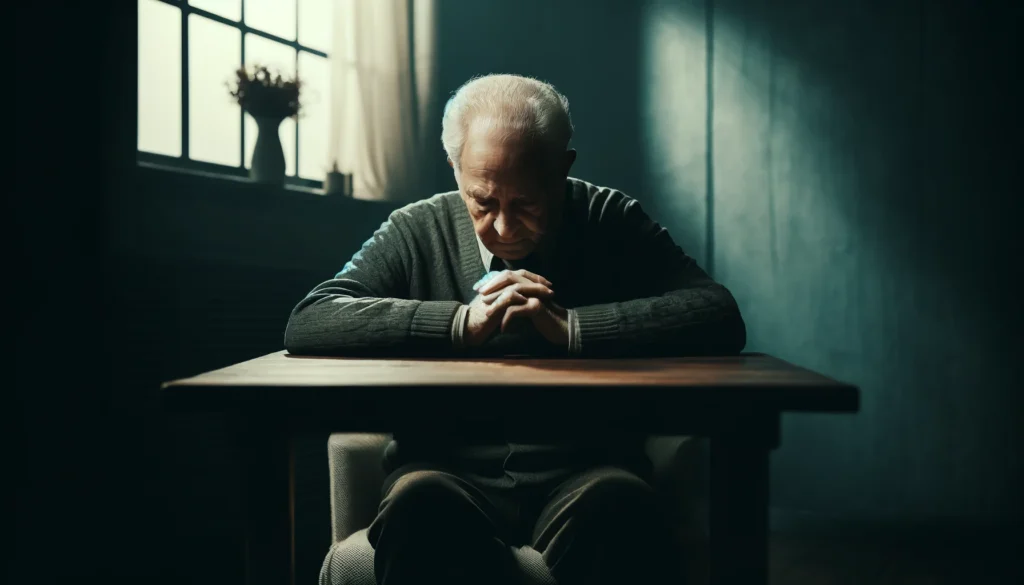Blog
Common Forms of Elder Abuse | How to Spot Them All

Is your loved one truly safe and cared for in their twilight years? Despite the veneer of security often projected by long-term care institutions, the unfortunate reality of elder abuse presents a darker, more complex problem to unravel.
Abuse wears many masks.
The gravest abuse often goes unnoticed, lurking behind closed doors or beneath ostensibly benign interactions. It is a silent epidemic, one demanding an urgent and educated response.
Understanding Elder Abuse Types
Elder abuse is a multifaceted issue that manifests in various deleterious forms, each with distinct characteristics and repercussions. Predominant among these are physical abuse, emotional or psychological abuse, financial exploitation, sexual abuse, and neglect. Each type inflicts harm in its own insidious way, with neglect being particularly prevalent in long-term care settings. This lack of proper care, whether in nursing homes or assisted living facilities, can lead to dire consequences for the vulnerable elder population. Identifying and understanding these forms of abuse is the first step toward prevention and ensuring justice for the victims.
Physical and Emotional Trauma
Physical harm to seniors is often visible—bruises, broken bones—but the emotional scars from abuse is often hidden.
“Every year, countless seniors suffer silently from physical and emotional abuse, their voices stifled by fear and dependency.”
While the physical injuries may heal over time, the psychological torment can endure, seeding long-term distress, anxiety, and a profound sense of isolation. Acknowledgment of abuse is the linchpin in healing—recognizing the signs of physical harm and emotional turmoil is crucial to breaking the cycle and facilitating recovery.
Financial Exploitation Risks
Financial exploitation of elders occurs covertly and can swiftly decimate an elder’s life savings, often leaving them destitute and in despair.
Elders with diminished capacity are especially vulnerable to financial abusers.
Unscrupulous individuals often exert influence to modify wills or power of attorney, turning elders into victims of fraud, deception, or theft. It starts with small, seemingly benign actions and escalates into complete financial control.
Elders may feel shame and helplessness, reluctant to report financial exploitation due to fear of retribution, loss of independence, or because the abuser is a family member. Thus, a robust framework for monitoring and intervention is critical to safeguard their assets and dignity. If you sense misuse of an elder’s financial resources, contact us today.
Identifying Nursing Home Neglect
Monitoring a loved one’s wellbeing in long-term care settings is essential for detecting signs of nursing home neglect. Unexplained injuries, sudden weight loss, or changes in hygiene may indicate a lack of adequate care or neglectful attitudes from staff.
It is paramount to understand that neglect may manifest in various forms such as bedsores, inadequate medical attention, or environmental hazards. These indicators often reflect systemic issues within a facility, necessitating vigilance and sometimes legal recourse to protect vulnerable elders.
If observed, signs of understaffing or indifference amongst the care providers should prompt further investigation. For assistance, visit our dedicated pages on Nursing Home Neglect and Assisted Living Neglect.
Signs and Symptoms
Elder abuse manifests in multifarious ways.
Primarily, elder abuse might be evidenced through physical signs – bruises, abrasions, or bedsores. These may be unintentional consequences of neglect, or they could be indicative of deliberate harm. Furthermore, frequent accidents or injuries occurring in a care environment should raise immediate concerns and warrant meticulous investigation.
Behavioral changes can indicate mistreatment.
It’s essential to recognize emotional withdrawal – a clear, distress signal. Sudden mood swings, depression, or fearfulness when in the presence of caregivers can point toward emotional or psychological abuse, which may be subtler but just as damaging as physical harm.
Financial irregularities suggest exploitation.
Not to be overlooked are signs of financial exploitation, which can be devastating. Unexplained withdrawals, alterations in wills, or the unusual transfer of assets should trigger alerts, particularly in settings where elders are dependent on others for their financial management.
Observations should be acted upon without delay.
When these indicators are noticed, they call for immediate attention. A detailed record of signs and concerns, coupled with prompt reporting to appropriate authorities, can protect seniors from further harm. For legal support or guidance, do not hesitate to reach out through our contact page.
Legal Recourse for Families
Immediate action is paramount.
The knowledge that a loved one may be the victim of elder abuse can be distressing and emotionally overwhelming. It’s crucial for families to know that when elder abuse occurs, there are legal avenues available to seek justice and reparation. Proving abuse and holding the responsible parties accountable is essential, and securing experienced legal counsel is often the first step in the process. Timely intervention can prevent further harm and afford the victim the protection they deserve.
Seek counsel promptly.
Retain experienced legal representation.
The path to justice matters.
Remember, the fight for justice is ongoing.
Assisted Living Neglect Specifics
Assisted living facilities, designed as supportive environments for elders, can sometimes fail in their duty of care. Instances of neglect in these settings can manifest subtly, making them particularly insidious and damaging to residents. It is imperative to recognize signs of neglect, which include poor personal hygiene, unattended health issues, and a noticeable decline in emotional well-being, as they can be indicative of deeper, systemic problems within a facility.
In the landscape of elder care, assisted living neglect takes on a form akin to a “silent malady.” Often less overt than physical abuse, neglect in an assisted living context can be the result of inadequate staffing, insufficient training, or systemic oversight failures. It is critical for families to remain vigilant for the indications of such neglect, which can range from unexplained weight loss to a lack of engagement in previously enjoyed activities, as these signs can signal a deterioration in the standard of care.
Differentiating From Nursing Home Abuse
Assisted living neglect is distinct.
Assisted living neglect, while equally serious, is subtly different from nursing home abuse. In assisted living settings, neglect often stems from a lack of attention and resources dedicated to the residents. This can manifest as insufficient caregiving, inadequate oversight, or lapses in the basic provision of care. Conversely, nursing home abuse often involves intentional acts of harm or negligence by caregivers or other staff members.
Neglect is more passive in nature.
Facilities may fail in duty of care passively. Assisted living neglect is characterized by a passive failure to provide necessary care, as opposed to the active maltreatment found in some nursing home abuse cases. This distinction is significant when advocating for the rights and well-being of the elderly.
Look for subtle, yet harmful signs.
One must vigilantly monitor for subtle neglect indicators. These can include residents’ unmet medical needs, diminished social interactions, or a decline in facility conditions, which may not always be as conspicuously alarming as the more visible signs of active abuse common in nursing homes.
Understanding these differences is vital for taking appropriate legal action. By recognizing the nuanced aspects of each scenario, families can seek appropriate legal recourse, ensuring that their loved ones reside in a safe and nurturing environment. If you suspect a loved one is a victim of assisted living neglect, please do not hesitate to contact us for guidance.
Action Steps to Protect Loved Ones
Begin with thorough research on potential care facilities, examining state reports, and visiting in person to assess the quality of care and environment. It is crucial to scrutinize the qualifications of the staff and to observe their interactions with residents, ensuring a compassionate and attentive atmosphere.
When a loved one is in care, maintain a consistent presence. Frequent visits can deter neglect and provide insight into the daily operations and resident interactions.
Stay informed about your loved one’s rights and the regulations governing their care. Familiarity with legal protections (such as the Older Americans Act and other elder rights legislation) empowers advocacy and action.
Engage in open dialogue with care providers to foster transparency regarding your family member’s health and well-being. Regular communication can identify and address potential neglect early.
Should there be indicators of neglect, document everything in detail. Record dates, times, and descriptions of incidents, including photographs if necessary. Such meticulous records strengthen the case if legal intervention becomes necessary.
Finally, if you identify signs that your elder’s care may be compromised, act decisively. Consult experienced elder abuse attorneys who can guide you in protecting your loved one from further harm.
Preventing and Reporting Elder Abuse
To mitigate the risk of elder abuse, engagement and vigilance are paramount. Establish a robust network of communication between family members, caregivers, and the elderly individual to ensure a collective watchfulness. Emphasize the importance of respecting the elder’s autonomy and dignity while monitoring for signs of abuse or neglect, such as sudden behavioral changes, inexplicable injuries, or financial anomalies. Prompt reporting of any suspicions to the appropriate authorities is essential. Additionally, it is vital to seek legal counsel from attorneys who specialize in elder law, as they offer the requisite expertise to navigate the complexities of these cases and to formulate a resolute response. Should you suspect elder abuse or require advice on such matters, please do not hesitate to contact us.
Proactive Measures for Safety
Effective preventive strategies stem from thorough understanding and anticipation of risks inherent to elder care environments.
Moreover, implementing a preemptive approach to detect early signs of mistreatment is crucial. Relatives should consider frequent, unannounced visits, engaging with staff constructively, and participating in care planning sessions. Such direct oversight can deter potential abusers and reinforce a culture of accountability within the care facility. It also enables family members to spot any discrepancies or irregularities in the elder’s condition that could signify abuse or neglect.
Additionally, clear and well-documented care plans are an indispensable line of defense. These should delineate specific care needs, preferences, and any special instructions that caregivers must adhere to, thus minimizing the ambiguity that can sometimes lead to inadequate or abusive care.
Finally, investing in legal safeguards such as powers of attorney or health care proxies can be instrumental in protecting an elder’s interests. By legally designating trusted individuals to make decisions on their behalf, elders can have a fortified buffer against exploitation. Advanced directives and estate planning are also critical in safeguarding assets and ensuring that the elder’s wishes are honored, thereby reducing the potential for financial abuse.
How to Report Suspected Abuse
When you suspect elder abuse, be observant and meticulous in gathering information about the circumstances you deem suspicious.
Confronting abuse directly can be risky, hence, it’s essential to approach the relevant authorities with your concerns. Reliable agencies such as Adult Protective Services (APS) and local law enforcement are responsible for investigating allegations of abuse.
Be prepared to provide details including the elder’s personal information, the nature of the suspected abuse, and any evidence you might have. This may include photographic documentation, financial records, or personal testimonies.
In cases of immediate danger, contact emergency services without delay. For non-urgent situations, long-term care ombudsmen serve as an invaluable resource for addressing concerns within care facilities.
For legal guidance and representation, reach out to us today!



